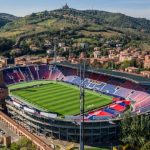The Stade Vélodrome in Marseille is one of the most iconic and fascinating sporting venues in all of France. Located in the bustling port city of Marseille in the south of France, this stadium has a rich history and has its roots in the country’s sporting culture. With a capacity of over 67,000 spectators, it is one of the largest stadiums in France and is the home of the famous football club Olympique de Marseille.
Follow us on social networks to stay updated on the latest foreign football news and exclusives: Instagram, Facebook e X.
Index
History
The history of the Stade Vélodrome dates back to 1937, when it was built primarily as a velodrome, hence its name. This multi-purpose stadium was initially intended for cycling competitions and had a capacity of around 15,000 spectators. However, over the years, it has undergone several renovations and expansions to accommodate sporting events of various disciplines, including football and rugby.
The stadium’s real transformation came in the 1970s, when it was renovated to host football matches and increased its capacity to over 55,000 spectators. This was a crucial moment in the stadium’s history, as it began to become the home ground of Olympique de Marseille, one of France’s most prestigious football clubs.
Olympique de Marseille

Olympique de Marseille, known simply as “l’OM,” is one of the most renowned and followed football clubs in France. Founded in 1899, the team has a long and proud history in French football and has won numerous titles in Ligue 1, the top football division in France. The team has a passionate fan base and the Velodrome is their meeting place.
OM’s home matches at the Stade Vélodrome are often spectacular and full of emotion. The fans, known as the “Marseillais,” fill the stadium with chants and banners, creating a unique atmosphere that is famous throughout the world. The matches between OM and their rival teams are particularly intense and attract the attention of football fans from all over the world.
Renovations and Modernization
Over the past few decades, the Stade Vélodrome has undergone major renovations to ensure it is up to modern standards. The most significant of these renovations occurred in preparation for the 1998 FIFA World Cup, which saw France host the tournament. In anticipation of the event, the Velodrome was completely renovated and expanded, bringing its capacity to over 60,000 spectators.

This renovation has transformed the Velodrome into a world-class football stadium, with state-of-the-art facilities for players, spectators and media. Its prime location next to the Mediterranean sea offers breathtaking views, which makes the experience of watching a match here even more special.
Architectural Features
The Velodrome’s architecture is a fascinating mix of old and new. Its external facade features a classic design, while the interiors are modern and equipped with the latest technologies. One of the architectural highlights is the roof, which covers a large part of the stadium and offers coverage to fans even during inclement weather.

One of the stadium’s most emblematic features is its large video screen, known as the “Virage Sud.” This huge screen is located above one of the stadium’s curves and is used to show game replays, fan footage and announcements during matches. It has become an icon of the stadium and a focal point for fans.
Important Events
In addition to football matches, the Stade Vélodrome has hosted numerous sporting and cultural events of national and international importance. During the 1998 World Cup, it was one of the main venues where matches of the tournament were held, attracting the attention of fans from all over the world.
Furthermore, the Velodrome has been used for concerts by international artists. Its vast capacity makes it an ideal choice for large-scale musical events. These concerts have included performances by world-famous artists such as U2 and The Rolling Stones, attracting thousands of fans.
The Future of the Stade Vélodrome
The Velodrome has undergone another phase of renovation and modernization in recent years. Local authorities have worked to further improve the stadium and create high-quality training facilities for OM. These investments are aimed at ensuring that the Stade Vélodrome remains a state-of-the-art facility and is capable of hosting world-class events.

Furthermore, the Velodrome was selected as one of the venues for the 2016 European Football Championship matches, which saw European national teams compete for the continental title. This further consolidated the Velodrome’s position as one of Europe’s leading stadiums for international football.
Conclusion
The Stade Vélodrome in Marseille is much more than just a stadium. It is an icon of French sport and culture, a place that has seen the celebration of epic victories, the passion of the fans and the energy of concerts by international artists. Its rich history, unique architecture and central role in French sport make it a truly special place. With further modernization projects underway, the Velodrome’s future looks even brighter, ensuring that it will continue to be a point of reference for football and culture fans in France and beyond.













